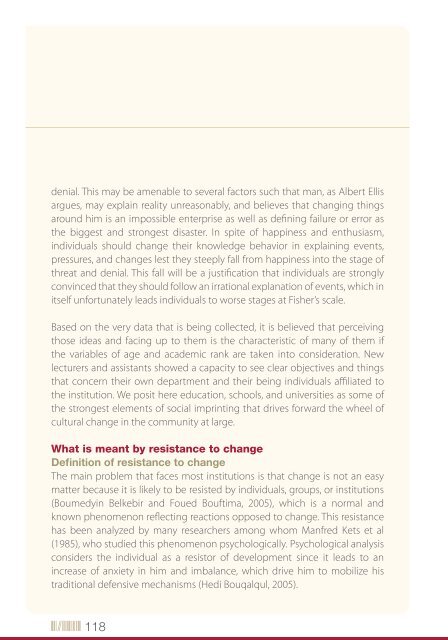General Supervisor
General Supervisor
General Supervisor
You also want an ePaper? Increase the reach of your titles
YUMPU automatically turns print PDFs into web optimized ePapers that Google loves.
denial. This may be amenable to several factors such that man, as Albert Ellis<br />
argues, may explain reality unreasonably, and believes that changing things<br />
around him is an impossible enterprise as well as defining failure or error as<br />
the biggest and strongest disaster. In spite of happiness and enthusiasm,<br />
individuals should change their knowledge behavior in explaining events,<br />
pressures, and changes lest they steeply fall from happiness into the stage of<br />
threat and denial. This fall will be a justification that individuals are strongly<br />
convinced that they should follow an irrational explanation of events, which in<br />
itself unfortunately leads individuals to worse stages at Fisher’s scale.<br />
Based on the very data that is being collected, it is believed that perceiving<br />
those ideas and facing up to them is the characteristic of many of them if<br />
the variables of age and academic rank are taken into consideration. New<br />
lecturers and assistants showed a capacity to see clear objectives and things<br />
that concern their own department and their being individuals affiliated to<br />
the institution. We posit here education, schools, and universities as some of<br />
the strongest elements of social imprinting that drives forward the wheel of<br />
cultural change in the community at large.<br />
What is meant by resistance to change<br />
Definition of resistance to change<br />
The main problem that faces most institutions is that change is not an easy<br />
matter because it is likely to be resisted by individuals, groups, or institutions<br />
(Boumedyin Belkebir and Foued Bouftima, 2005), which is a normal and<br />
known phenomenon reflecting reactions opposed to change. This resistance<br />
has been analyzed by many researchers among whom Manfred Kets et al<br />
(1985), who studied this phenomenon psychologically. Psychological analysis<br />
considers the individual as a resistor of development since it leads to an<br />
increase of anxiety in him and imbalance, which drive him to mobilize his<br />
traditional defensive mechanisms (Hedi Bouqalqul, 2005).<br />
118<br />
From this perspective, resistance to change can be defined as “a normal<br />
emotional response toward what is considered a real or likely danger that<br />
threatens the current work style. Resisting change is as inevitable as change<br />
itself. Man by nature leans toward resisting changing the current situation<br />
(tending toward stability) owing to the disturbance, anxiety, and internal<br />
tension that might be occasioned in an individual’s personality because<br />
of lack of certitude about subsequent outcomes” (Abdussalem Makhloufi<br />
and Abdulkarim Belarbi, 2005; Jameleddin La’wisette, 2003). In this sense,<br />
Daryl Connor, founder and president of the Institutions and Organizations<br />
Development Center and author of Managing at the Speed of Change (1992)<br />
wrote: “We do not resist alien and new things in our life as much as we resist the<br />
outcomes of these changes, which consist in losing control. In reality, it can be<br />
said that the expression “resisting change” as misleading since people do not<br />
resist change as much as they resist its negative outcomes and repercussions.<br />
It is that feeling of fear from ambiguity that comes from losing what is familiar<br />
and normal” (quoted in Tarek Al-Sweedan, 2001, p. 33).<br />
According to most estimates, 50-70% of initiatives of change that occurred in<br />
the 1980s and 1990s in restructuring companies failed to attain the intended<br />
results while engineers responsible for this restructuring in those companies<br />
indicated that the rate of success among 1000 companies was less than 5%<br />
and may reach 20% (Tarek Al-Sweedan, 2001, p. 11). This is due to resistance to<br />
change, i.e. individuals’ lack of responsiveness. Change is not easy since it often<br />
finds resistance from individuals, groups, and institutions.<br />
Example and model of resistance to change<br />
On the educational level, developmental plans and applications for<br />
international academic accreditation have been set up to raise the global<br />
ranking of schools and universities as an expression of the ambitions of those<br />
responsible for education, students, parents, and citizens so that education<br />
119


